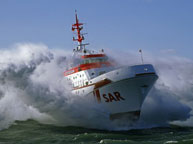
Shipbuilding is seen as an indicator of the state of the world economy. That is why a recent report caused some excitement – it would seem that the industry is recovering. And not just in South Korea, which has occupied a leading position in this sector the past few years. Even outside South Korea, the shipbuilding industry is gradually recovering after the years of crisis. Experts see growth opportunities primarily in specialist ships, for example for equipping off-shore facilities for oil and gas production.
Speciality chemicals company Lanxess also benefits from this turn of events. In the tough environment on the high seas, cold flexible and oil-resistant cable sheathings made from its halogen-free, flame-retardant Therban/Levapren blends have proved invaluable. This is where blends from the two elastomers HNBR or hydrogenated acrylonitrile-butadiene rubber (Therban) and EVM or ethylene-vinyl acetate rubber (Levapren) come into their own thanks to their resistance to oils, lubricating greases and drilling chemicals, says Lanxess.
“Elastomer cable sheathings may still be a niche market compared to more common materials, such as polyethylene or PVC,” says Jörg Stumbaum, Technical Marketing Manager in the High Performance Elastomers business unit of Cologne-based synthetic rubber pioneer Lanxess. “But these materials cannot keep pace when it comes to more challenging applications. From a technical perspective, this is where synthetic rubbers are a better solution.”

One example is cable sheathings for shipping on the high seas – which is in many respects a special area of application, since conditions at sea can be particularly harsh.
“The key to success is the flexibility at very low temperatures of our highly specialised synthetic rubbers Therban and Levapren. Engineers today demand cable sheathing materials that remain flexible at temperatures below minus 40°C. There are various materials that can break through this mark. However, if there are also special safety requirements, then 50:50 blends of Levapren and our HNBR elastomer Therban have the credentials to be the material of choice. They not only remain flexible at temperatures well below minus 40°C, they also exhibit high oil resistance and outstanding flame-retardant properties even in this temperature range.”
These kinds of temperatures may be unlikely in moderate temperate zones, but at sea, particularly in extreme latitudes such as the Arctic Ocean, they are all too common. That is why shipbuilding engineers tend to use cable sheathings manufactured using Therban and Levapren for ships that will be navigating these regions.
Most commonly used are Levapren 600 and Therban LT 2007. The latter Therban grade is specially designed for use at low temperatures, is fully hydrogenated and has a residual double bond content of less than 0.9%. This value ensures high ageing resistance and robustness against ozone and UV light – both of which are everywhere at sea.
Flame retardance an important factor
At the same time, these halogen-free materials meet high flame retardance and oil resistance requirements, such as those laid down in the stringent Norwegian standard NEK 606. On board ship, a fire can quickly grow into a catastrophe – flame retardance is therefore particularly important.
“Thanks to their high polarity, Therban/Levapren blends can incorporate large quantities of inorganic halogen-free fillers, such as aluminium hydroxide,” explains Stumbaum. Should an external fire ignite these flame-retardant cable sheathings, only limited amounts of smoke will develop – which is important for keeping evacuation routes visible as long as possible. The blends’ low tendency to swell in oil also helps to keep smoke to a minimum in an emergency. “Most importantly, however, halogen-free materials such as Therban and Levapren do not produce corrosive hydrochloric acid in a fire, which can damage machinery and injure people. This is essential when people are moving in very confined spaces and property has to be protected.”
This oil resistance also gives cable sheathings made with Therban and Levapren exciting potential in a similar industry – oil exploration and fossil fuel extraction. “Again, extremely stringent flame retardance standards have to be met for this industry,” says Stumbaum. At the same time, these cables come into contact with diesel, oils and lubricating greases, but also with drilling fluids and drilling mud that can contain aggressive organic substances. Conventional cable sheathing materials would be ill-suited for this job just because of their tendency to swell.
These two areas of application even overlap – the hunt for new sources of fossil fuels is taking geologists to ever more remote – and colder – parts of the world. “Lanxess materials therefore have their uses not only in sustainable energy sources such as wind power, but also contribute to ensuring the supply of energy from natural gas and oil. The technology required for this is becoming increasingly demanding – which makes Therban and Levapren the ideal materials,” says Stumbaum.
(PRA)




















